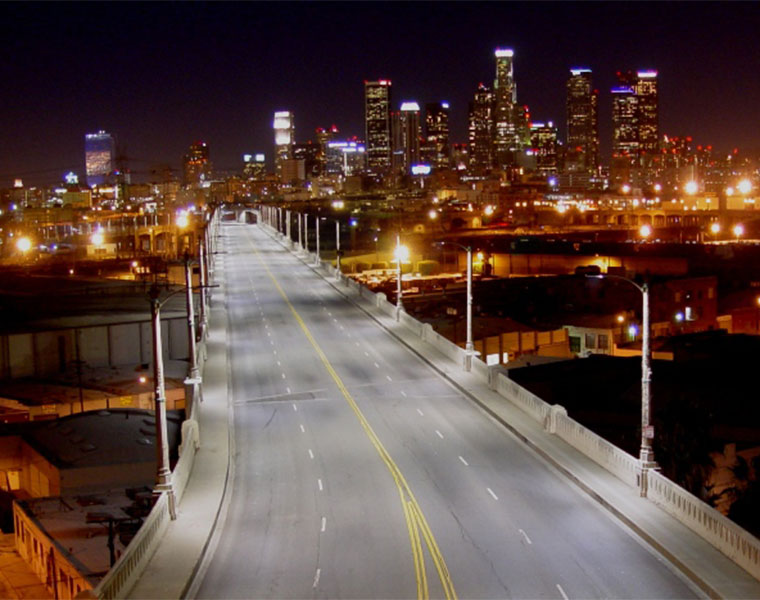By Jim Williams
Do you live in a city that has switched to LED street lighting? If so, you have most likely noticed a drastic difference. Gone are the yellow hues that appear to be a blur of light that break up the night and shed a dank glow of light on your street or sidewalk. Instead, thanks to LED lighting, city streets are vibrant and popping with color and clarity, showing every nook and cranny of the street all the way down to any cracks in the concrete or asphalt.
While the switch to LED’s has been, well, enlightening, a recent report from the American Medical Association (AMA) says “not so fast.” In fact, the AMA article strongly suggests cities should be careful when selecting LED lighting options to “minimize potential harmful human and environmental effects.”
We hit the streets to get the scoop on what impact, if any, LED street lights are having on humans and the environment. The first stop was with one of the largest cities in America – the City of Los Angeles.
We reached out to the LA Bureau of Street Lighting and had the pleasure of talking with Assistant Director, Norma Isahakian. The City of Los Angeles is currently on the tail end of a project to replace their streetlights with LED lighting. “We have been switching to LED lights since early 2009,” stated Isahakian. “We have over 215,000 street lights in Los Angeles. We have already converted about 80% of the city to LEDs. We are probably going to take a couple more years to finish as we have mainly only the decorative poles we are trying to work on right now. Those take a little more time as they are a little more challenging than the ‘cobra’-type poles.”
The following image shows the dramatic difference between the city, before and after LED.
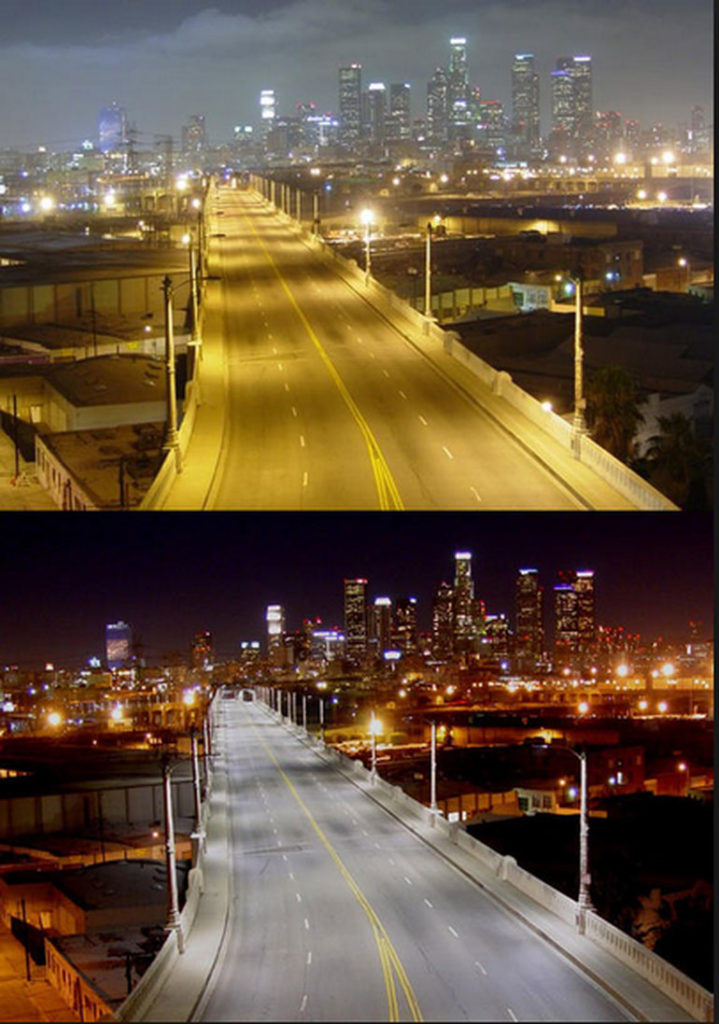
Los Angeles has gone from the old High Pressure Sodium (HPS) mercury vapor metal halide lights to LED. “The colors have changed,” claims Isahakian. “The city looks brighter. Everyone seems to like the program. We haven’t had any complaints.”
Isahakian added, “For the most part, our fixtures are not supposed to be going into anyone’s residences. When we started the program, all of our fixtures were geared toward the roadway and the sidewalk area. That has always been our history regardless of any report, that’s just the way we operate.
“And, of course, living in LA, we’re always cognizant of light, so we’ve always tried to do what is called the cut-off fixtures. We had a lot of those out in the city. So, when replacing those one-to-one we were actually noticing that the up light was reduced. That’s always been our history of balancing that between glare, not only for the motorists, but more for going into peoples’ residences and also minimizing up light as well.”
For Los Angeles, being one of the first major cities to convert to LED street lights had its advantages – and disadvantages.
“We didn’t really have too many other cities to model this after,” noted Isahakian. “At the time we started, there really wasn’t much movement in the cities, so we kind of had to go out first. A lot of times, other cities were calling us to see what we were doing and wanting to know what we did.
“When LEDs first came out, there was a lot of uncertainty and there were a lot of fixtures that weren’t quite up to where we needed them to be for our standards. We did a lot of testing in the beginning to evaluate the fixtures.”
When the City of Los Angeles started converting to LEDs in 2009, there was about a 40% energy reduction. According to Isahakian, with the new bulbs and technology, LA is now looking at around 75%. “That was the big motivating factor from the beginning,” she said. “That, plus LEDs last longer. Every year our engineers go out and take readings to determine how well the first set of lights are holding up, but we may go out and start re-lamping them depending on their age and on what the energy savings are. If we can get a turnaround, or payback, of two to three years, it might make sense to go ahead and do that.”
A Contractor’s/Distributor’s Perspective
Our second stop to get to the bottom of the AMA guideline on LED street lighting was Steve Eilmann, a partner at Braco Electric in Missouri. “LED isn’t stuck with your traditional, standard street light like you remember as a kid,” pointed out Eilmann after hearing the details of the AMA guidelines. “The study is outdated. I’m sure, like typical research products – this wasn’t something they thought about on a Friday and then published on Monday. They most likely submitted their grant, got approval and then five years later wrote a thesis on it. By the time it is published, they could be behind the times on it.
“(That) they mention putting up shields or installing dimmers is encouraging,” adds Eilmann. “Technologies have changed. The lighting industry is making huge strides in making lighting more appealing than what it has been in the past. In particular, street lighting has evolved tremendously just in the last couple of years. They have sensing lights for communities now, where each individual head is a Wi-Fi repeater. It can be run through a system that senses cars and movement. For example, if you are driving down the road the LED light may be at 10% and as you approach the light it will jump up to 100%.”
Eilmann went on to explain another technology that would effectively eliminate any concern of LED street lights shining into bedroom or living room windows. “The benefit to LEDs is, you can change the spectrum of an LED with little lenses that look like fish eyes,” Eilmann explains. “We can put a different lens on it and create a perfectly straight line and literally point it wherever we wish. If you have a cobra head – like they were talking about in LA – and you put a particular lens on there, that allows 25′ of candle light on the street, but they can set it up where it draws a perfect straight line of light at the sidewalk.
“It’s not like a flashlight where you shine it on a wall and you are stuck with the shape of the flashlight,” continues Eilmann. “It’s not always going to be round coming off the light. Now, you can change the angle of the LED with that lens to create shapes. If they want to create a straight line with that fixture, you don’t need big shields on it – you can use your regular LED and design a lens that goes over the top of that LED that will cut a straight line so the light will not go past the point you desire. Another positive to this procedure is, it also eliminates light pollution.”
Eilmann went on to explain how a community might determine it wants streetlights in a certain area to be at 2,000 Kelvin (K) so it look likes the moonlight; they can program it to be 2,000 K between 9:00 p.m. and 5:00 a.m. LED lights can also be tunable so a city can control the light under any situation – for example, to control any possible glare during a fog, but still make the light adjust for cars as they drive by so the driver can have optimal vision. Tunable LED may not fit every city’s budget, but it does show how far LED technology has come in just a few years.
Speaking of budget, it still boils down to getting the most bang for your buck. In Los Angeles, as mentioned above, they are now seeing up to a 75% energy reduction and quicker payback. That payback is determined in part by a government listing called DLC Rating. DLC stands for DesignLights Consortium. The DLC rating focuses strictly on commercial lighting, while Energy Star rates a wide range of consumer products. (More on DLC/Energy Star.)
The basis behind DLC rating is to set requirements for lumens per watt for rebates and incentives. Two years ago, the standard was 100 lumens per watt. Technology over the past two years has stepped almost every six months going from 100 lumens, to 110, then 120 lumens per watt – the standard for industrial use now is 130 lumens per watt. There are even some 170 lumen bulbs available. What this means is LED lights are capable of producing almost double the ratings compared to when they started.
Since we are talking about Los Angeles, we will continue to use them as an example. If they were to purchase lights being produced this summer to this fall, they would be approximately 100 lumens per watt better than when they started their LED conversion program back in 2009.
“A lot of the fixtures you get now are 130 lumens,” chimes in Eilmann. “By next year this time everyone will have the 150’s and six months after that everyone will have 170’s. I have a hard time buying too much surplus of product just because of that same reason – I want to make sure I am on top of the best every time, but it is difficult for me to buy a few hundred pieces of one thing at one time and stock it in our warehouse knowing that in six months I am going to be able to get something that is the next step up; and when you go to the next step up, your rebates can be calculated per savings. People want the one that is the best, that way their rebate is bigger. It’s amazing how quickly it’s turning. I don’t know how much further they can go, but I never would have expected to see 170 lumens per watt in the last two years when it was just 100 lumens per watt a couple of years ago.”
The LED Light Impact from a Doctor’s Perspective
Ophthalmologist Nathan Welch, MD, from Welch, Allan & Associates in Twin Falls, Idaho says that yes, while the blue light in LED lights can affect circadian sleep rhythms, he has yet to treat a patient because of LED street lights. “I haven’t had anyone complain to me about LED street lights in terms of their sleep patterns or glare,” Dr. Welch said. “Theoretically, both could cause problems, but at least in my practice, no one has mentioned street lights. Car headlights have been an issue and the sleep issue has been one, but I’ve never had anyone link it to street lights – mainly just LED phones and TV screens and computers.
“If you are in your house, the street lights really shouldn’t be affecting you. But a lot of people are switching to LED lights in their homes so it is a real thing that the blue lights can affect your circadian rhythms,” concluded Dr. Welch.
Dr. Patrick Whitworth, OD, from Independence, Missouri says he tends to agree with the AMA article. “As far as exposure times, it depends on the emittance levels of the source,” he said. “There are studies out there that show there is potential damage that can occur with the retina, specifically the macula – which contains blue/yellow cones that are susceptible.
Dr. Whitworth did not talk specifically about street lights, but did say, “I have had many patients complain about the effects of halogen lights from cars with glare, especially older patients who may have some cataract growth. With that in mind, I agree with the AMA article that filters, or low remittance blue light from LED’s would be ideal….both for the driver and for energy efficiency purposes.”
One of the sources Dr. Whitworth pointed to was a study done in 2014. In The Lowdown on Blue Light: Good vs. Bad, for the Review of Optometry, co-author Ronald Melton, OD pointed out that “there’s an increase in the use of digital devices and modern lighting—such as LED lights and compact fluorescent lamps (CFLs)—most of which emit a high level of blue light. CFLs contain about 25% of harmful blue light and LEDs contain about 35% of harmful blue light. Interestingly, the cooler the white LED, the higher the blue proportion. And by 2020, 90% of all of our light sources are estimated to be LED lighting. So, our exposure to blue light is everywhere and only increasing.
Dr. Melton’s research goes on to say, “Over time, our eyes are exposed to various sources that emit…(a) blue-violet light (e.g., the sun, LED lighting, CFLs). Combine that with the use of tablets, TVs, computer screens and smart phones, and there’s no doubt our exposure to blue-violet light is on the increase. This cumulative and constant exposure to the blue-violet light is going to accumulate over time and has the potential to cause damage to the retinal cells, which is going to slowly lead to retinal cell death and can in turn lead to age-related macular degeneration (AMD).
“The level of light emitted by newer energy-saving lighting techniques (e.g., LED, CFLs) is very high. For example, CFLs, white LED light and even sunlight emit high levels of blue-violet light compared to the rest of the blue light spectrum. This underscores the need for us to protect our eyes from the harmful bands of blue-violet light.”
In an effort to sum up our findings, it looks like the AMA article is based on valid concerns, but the trend is to continue to move to LED lighting with the public in mind – for their health and the health of the environment (and a better bottom dollar for the communities involved).
A different look at Los Angeles
The following pictures are of the City of Los Angeles. All three are taken from approximately the same location on Mt. Wilson over the span of 100+ years showing the growth of the city, and more specifically, the growth (and impact) of LED lighting.
1908
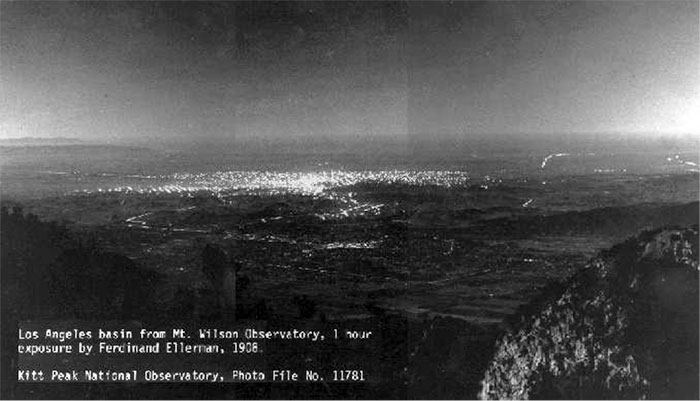
1988
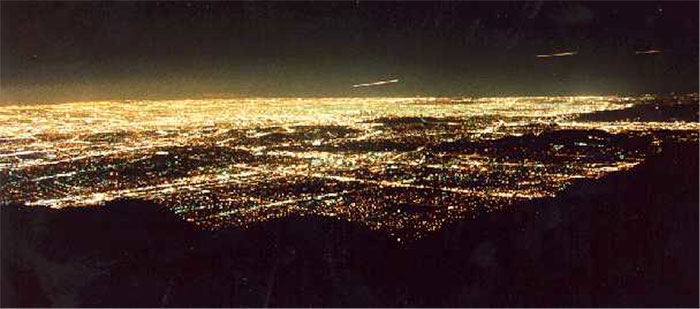
2012
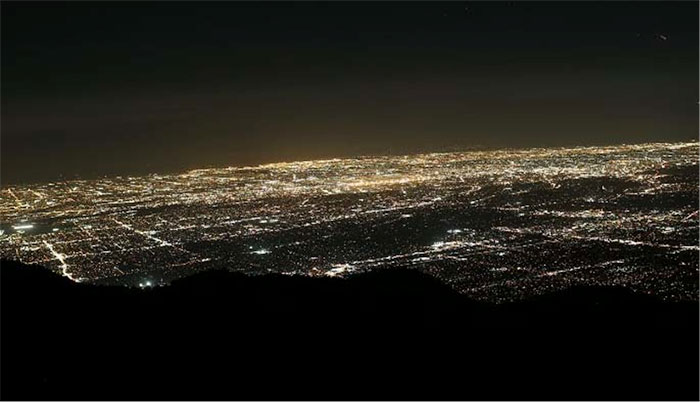
(Photos pulled from the City of Los Angeles’ Bureau of Street Lighting web site: http://bsl.lacity.org/).
Tagged with AMA, LED, lightED, Los Angeles, street lighting
